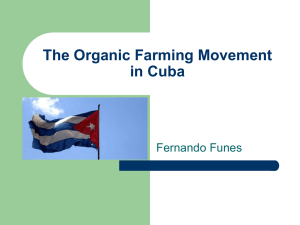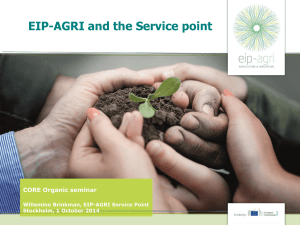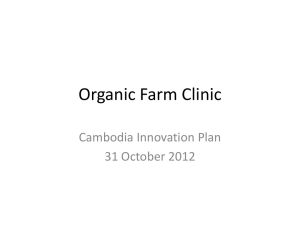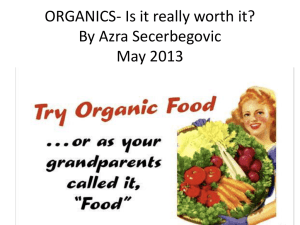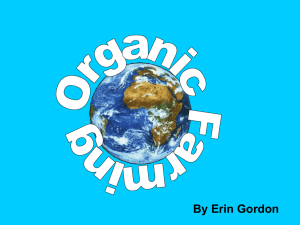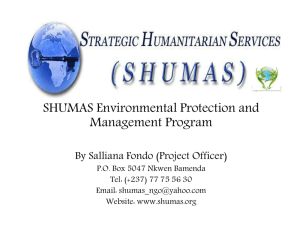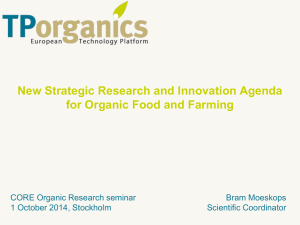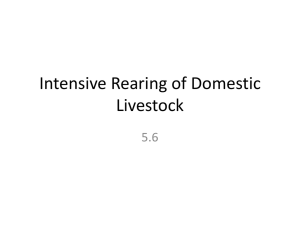PPT on Mission Organic Farming NE
advertisement
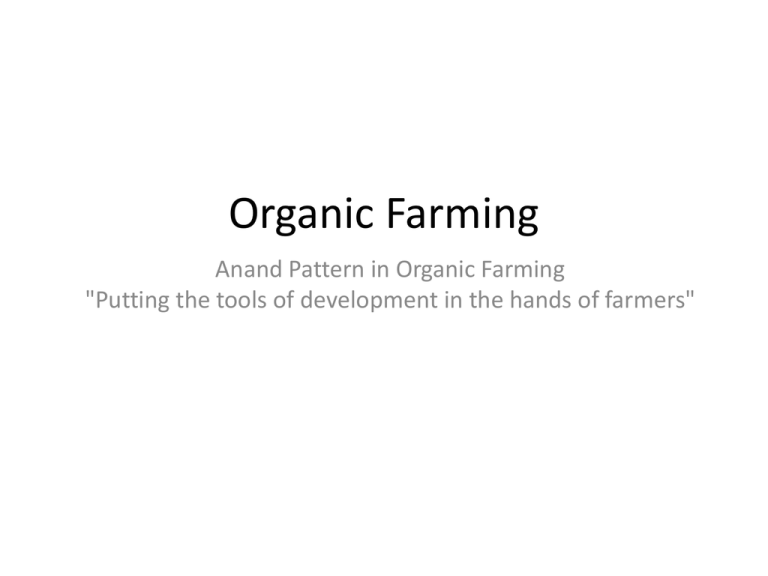
Organic Farming Anand Pattern in Organic Farming "Putting the tools of development in the hands of farmers" Plan of Presentation • • • • • • • What is Organic Farming? Status in India, NER Main learnings from NER Obejctives of OF scheme Implementation Strategy Implementation Components - I, II, III Organisational Aspects Coordination issues and Benefits What is Organic Farming? • Avoids synthetic inputs; incorporates technology with natural processes; integrates animal husbandry; and mobilises soil nutrients and nature-based protection • In India including NER, small holdings imply closeness to sustainable farming except access to broader markets • Currently, 4.72 mha certified incl. 0.6 mha cultivated • 135 varieties exported Rs3300 cr; domestic Rs600 cr. • 85000 ha in NER led Sikkim 75%, Naga 14%, Megh 6% Main learnings from NER • • • • Small holdings generally Quality inputs not available Technologies for production, pest control Aggregation costs for distributed small growers • Market access, limited value added facilities • Certification complexities Objectives of OF scheme • Mission approach; end to end • Address risks of climate, production, disease, market • Environmentally sustainable production • Conveniently marketable volumes • Farmer controlled valued-added production centres Implementation Strategy • • • • • • • • Contiguous clusters on microwatershed basis Women farmer focus relevant to NER, Prefer SHG covered areas Village as operating unit to Federation marketing Anand pattern of trickle to flood Integrating technology & local knowledge - farmer-led Focusing scientists for solutions based on local materials Continuous assessment of soils; bio-inputs support Hand-holding in management; subsidies as revolving funds - no personal freebies; • investment is for improving land productivity and farmer effectiveness. Principal Components - I • Baseline survey, PRA of farmers, Resource appraisal • Soil analysis: 5 items, 13 items, microbial, SH cards issue • Cluster of microwatershed 10-15 ha/ 25 farmers, Group saves for mutual credit as in SHG • Council of Clusters coterminous to village - 50-150 ha • District Federation of Clusters; 50-200 Councils (250010000 ha) eventually, less as it grows. • Support agencies, resource agencies help district units set up incl. agronomic packages Principal Components - II • Integrated farming systems; focus on 2-4 commercial crops plus multi/inter/mixed cropping, Animal Husbandry • Farm-level systems conducive to Organic certification • State-level biofertiliser, biopesticide production supplements • Revolving funds for inputs, animal husbandry with Council • Pilots possible for vermicompost - homestead and community or other innovation • Capacity building: TOT, trainers, farmer trainers, materials; local language • Convergence of schemes for NRLM, OF, watershed development, soil testing Principal Components - III • Service Centres for equipment hiring at Council, Federation • Village council collection, aggregation, washing, grading including for storage as may be required. • Federation level value addition and packing facility with phasing-out of management support, produce collection crates • Internal Control Systems geared to certification • Exposure visits, seminars etc Organisational Aspects • National: Director and YP, sub staff • Region: Integrate PMUs of NERCORMP, NERLP with PMU for OF under overall Director, LP and supervision of NEC and DoNER • State: State level Society set up under MOU, Training, Funds, Support Orgns • District: Manager, Staff under Federation including some costs of processing, testing, outsourced testing. Activities of area selection, organisation, training, PRA, surveys, soil testing and support with sector professionals; convergence. • Arbitration by district Committee headed by Dy Commissioner • Village Council: Secretary part paid; Cluster head honorarium for documents Coordination Issues • Bringing Livelihood schemes together • Uncertainty in elements, hence in costs (vermicompost, SHG savings may speed fund rotation); Expect total project investment at Rs 18,000 per ha • Timeliness of convergence will add costs (soil tests, OF, bio-input production, needs for animal husbandry) but may be small • Availability of seeds will require initial multiplication; hence delay • Ethnic disputes may affect supra Council solidarity • Need for mid-term reviews of components and re-strategising • Contribution by farmers, specific areas by State Govt, rest 100% programme Benefits of Programme • Increase in Organic production of commercial crops • Increase in area under commercial organic production • Greater income realisation by farmers • Farmer led process - less Government, little/no subsidy; focus on community building with community level revolving fund • Women empowerment and capacity building • Increased exports, domestic markets of quality value added products Thanks
